Authors
Poetry and Patriotism
Issue 4/1985 | Archives online, Authors, Essays
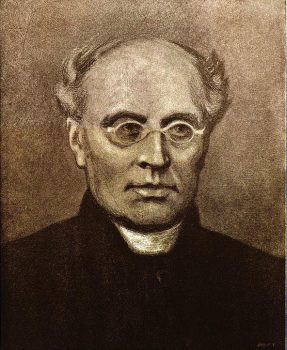
J.L. Runeberg. Painting by Albert Edelfelt. 1893.
Much revered, but little read today, Johan Ludvig Runeberg (1804-1877) is famed for his patriotism and glorification of war in a just cause. Yet Finland’s national poet did not write in Finnish, and never heard a shot fired in anger. It is, perhaps, time for a reappraisal.
What did he himself think about becoming a national poet?
Enjoyed it, probably? Who wouldn’t!
Did he write what he wanted and let
the people find their own interpretation?
Or did he write what he believed
the people expected
of a national poet?
Lars Huldén, 1978
It would not be inappropriate to begin a collection of thoughts about Finland’s ‘national poet,’ Johan Ludvig Runeberg, with a biblical text, Second Samuel, 1:25: ‘How are the mighty fallen!’ Runeberg does not own the position he once did, either in the world at large or in Scandinavia; even in his home land his exceptional grandeur has been reduced or, horribile dictu, smiled at. More…
Experiments with reality
Issue 3/1985 | Archives online, Authors
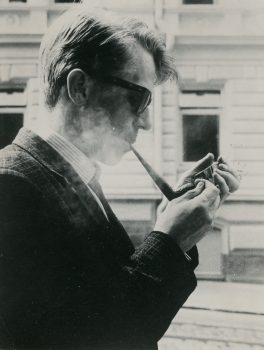
Väinö Kirstinä. Photo: SKS Archives
Väino Kirstinä (born 1936) regards himself as a member of the ‘second generation’ of Finnish modernists. His first collection of poems, Lakeus (‘The plain’) was published in 1961, followed two years later by Hitaat auringot (‘Slow suns’) and, the same year, by the work that gained him public recognition, Puhetta (‘Talk’). In 1979 Kirstinä commented on the aims of Puhetta: ‘the work … aimed to break the mould of Finnish modernism in some senses – hermetics, for example. I tried to bring everyday language into poetry – trams and fridges alongside the familiar symbols of mountains, lakes, beaches and birds. My poetry opened up, it developed into a kind of unclean lyricism.’
His interest in words as one of the constituents of poetry is characteristic of Kirstinä’s work, as is his search for the sources of modern poetry, such as the work of Baudelaire, which he has translated into Finnish, and the later tradition of surrealism and dada, which is clearly influential in his extensive collections Luonnollinen tanssi (‘Naturaldance’, 1965) and Pitkän tähtäyksen LSD-suunnitelma (‘Long-term LSD plan’, 1967). More…
The universal eye
Issue 2/1985 | Archives online, Authors
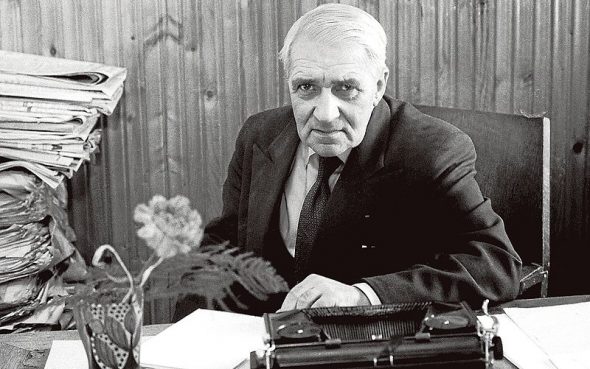
Gunnar Björling. Photo: Holger Eklund
Gunnar Björling (1887-1960) began his poetic career at the age of 35 with the collection of verse Vilande dag (‘Resting day’, 1922), which revealed the influence of romantic idealism and clearly showed its author’s preoccupation with ethical and philosophical problems of existence. Names such as those of Pascal and Spinoza, Guyau and Tagore, Dostoyevsky and Strindberg occur throughout this collection, the basis of which was formed by Björling’s study of the work of the great Finland-Swedish moral philosopher Edvard Westermarck, from whom the poet derived his concept of relativity and his philosophy of the unbounded. The dammed-up energy that can be sensed in this first volume breaks out with full force in Krosset och löftet (‘The cross and the promise’, 1925): with this, the phase of idealistic expectation comes to an end and Björling the expressionist emerges, giving utterance to ‘unbounded life’, in all its clarity and confusion, yet still within the same framework of ‘growing boundedness’: ‘We live in the concrete, and this gives our abstractions fateful wings.’ More…
Contrapuntal dialogue
Issue 2/1985 | Archives online, Authors
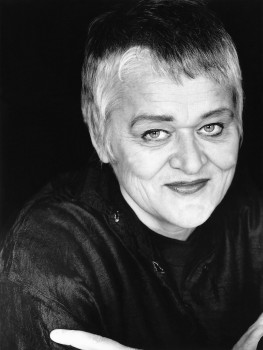
Pirkko Saisio. Photo: Laura Malmivaara
Pirkko Saisio (born 1949) is the author of five novels and a number of plays. Her first novel, Elämänmeno (‘Way of life’), appeared in 1975, when she was a young actress just graduated from the Finnish Theatre School, appearing in rep at Rovaniemi Theatre. By the time her next novel, Sisarukset (‘Sibling’), was published in 1976, Saisio had moved back to her native Helsinki and was working as a freelance writer and actress.
In addition to three stage plays, she has also adapted three of her novels for stage or television: Elämänmeno was shown on television in 1978 and Sisarukset in 1980, and the KOM Theatre staged its own highly acclaimed interpretation of her novel Betoniyö (‘Concrete night’, 1981) in 1982. Last year Saisio published a new novel, Kainin tytär (‘Daughter of Cain’), whose absence from the Finlandia Prize shortlist astonished many critics. In March her play Hävinneiden legenda (‘Legend of the lost’) was published as a book and staged at the KOM Theatre. Saisio herself appeared in the production, playing, among others, the role of Joan of Arc. In May she was awarded a Government Literature Prize for Kainin tytär. More…
The bad and the ugly in the writing of Pentti Haanpää
Issue 4/1984 | Archives online, Authors
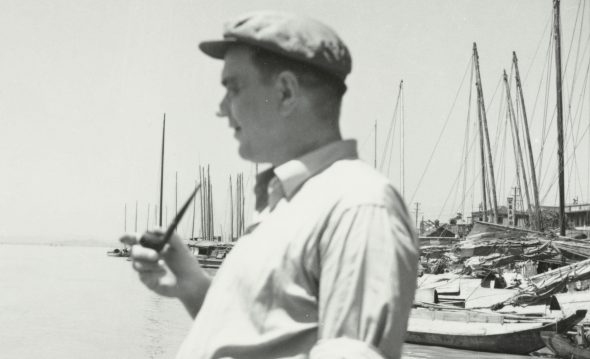
Pentti Haanpää. Photo: SKS Archives
Pentti Haanpää (1905-1955), author of ten novels and three hundred short stories, wrote about lumberjacks, woodsmen, crofters and smallholders; his individual style has established him as one of the most popular short story writers in Finnish literature.
The first full biography of Haanpää, by Vesa Karonen, Haanpään elämä (‘Haanpää’s life’), is to be published in January 1985 by Finnish Literature Society.
Haanpää’s strength as a writer is in his short stories. He is a man’s writer who writes about a man’s world: logging and other heavy manual work, hiking, war hunting, fishing, sport. His language, too: is masculine: rugged, sometimes rough, dense, laconic. Haanpää’s scale of emotions is wide and varied, but there is a bass note that is often sounded in his work. It is one of the characteristics that gives Haanpää’s work its particular stamp: his preoccupation with the bad and the ugly. More…
Joni Skiftesvik: arctic storyteller
Issue 4/1984 | Archives online, Authors, Interviews
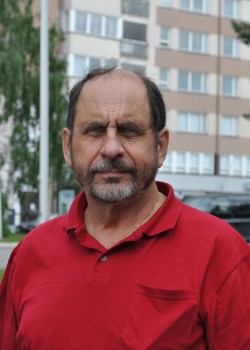
Joni Skiftesvik. Photo: Hilkka Skiftesvik
Olavi Jama interviews Joni Skiftesvik
We’re sitting on the fringes of the arctic zone, in the modern centre of Oulu, a town that built its wealth in the last century on tar export and sailing ships.
In front of us is the sea; behind us curves Oulujoki, the river that has for centuries brought Oulu writers stories from the north. The restaurant is filled with the bright light of midday; we want to see each other clearly.
JS: All summer the wind blows in from the sea. Now there’s a land wind. It comes from the east.
OJ: You’ve published only two books, but you’re hardly a typical debutant writer. All day you work for an Oulu publisher of romantic fiction, whose products attract hundreds of thousands of readers every year. What’s your job there?
JS: Publications director.
OJ: You returned from the Frankfurt Book Fair yesterday. Did you see anything there to interest you as an author?
JS: For a novelist or a short story writer, for a writer concerned with literature it was really quite a depressing sight. Long corridors and exhibition shelves by the kilometre. More…
Home and solitude
Issue 3/1984 | Archives online, Authors
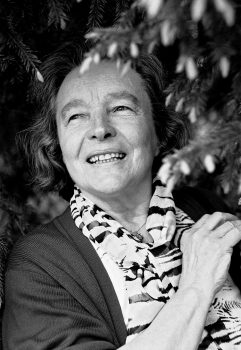
Eeva Kilpi. Photo: Veikko Somerpuro
By Eeva Kilpi’s own admission, the genre of the short story seems best suited for her themes. But she has also gained recognition as a novelist and poet, both inside and outside Finland. Among the many Finnish authors who have read and traveled widely, Kilpi assumes a somewhat unique position: the wider contemporary world with its interlocking problems can be sensed as the broader context of her writing; yet the foreground actions of her stories, with a few notable exceptions, take place in Finland, often in the backwoods of the Eastern border districts. Likewise, her main characters are unmistakably Finnish, from teenagers spouting Helsinki slang to old folks lapsing into a colorful Karelian dialect.
Eeva Kilpi was born in 1928 in Hiitola on the Karelian isthmus. Her latest novel, Elämän evakkona (‘Life’s refugees’, 1983) demonstrates again the author’s capacity for casting into the foreground gripping individual life stories while opening up in the background the epic journey of Finnish Karelians, uprooted in the last war from home and village and sent wandering around Finland in search of new livelihoods, homes and roots. Kilpi’s story is poignantly Finnish and reflects the journey she herself at the age of eleven started with her family from Hiitola. But it fits into the larger context of our own time, which produces growing numbers of evacuees and refugees with stories largely untold. More…
The stages of Aleksis Kivi
Issue 3/1984 | Archives online, Authors
The organic unity of written and performed drama is today considered an unarguable truth especially in acting circles. The work of Aleksis Kivi appears, on this view, anachronistic to say the least: he created the basis of Finnish drama at a time when the indigenous Swedish-language theatre was taking its first faltering steps and theatre in Finnish was not even dreamed of. And more: his most important works still inspire interpretation after interpretation, and audiences continue to flock to see his plays.
Kivi’s drama is no mere paper art, scribbled by an artist in a garret. Details from contemporary accounts reveal that Kivi was naturally drawn to acting, and presumably he had some gifts in that direction. Some of his friends thought him a good mimic. Kivi had marked out his first stage as a boy on the slopes of the Taabori mountain close to his home. His first play concerned the weekly trip to church; he sketched his own satirical version of the sermon and the reading of the banns. As a schoolboy and a student he invented and organised brigand plays in Helsinki and Nurmjärvi; scholars believe that his model was Schiller’s Die Räuber. In Siuntio he read Shakespeare aloud, in Swedish, to his saviour and patron Miss Charlotta Lönnqvist, and to her students of household economy – ‘although, of course, a lot had to be cut out.’ More…
The man and his work
Issue 3/1984 | Archives online, Authors
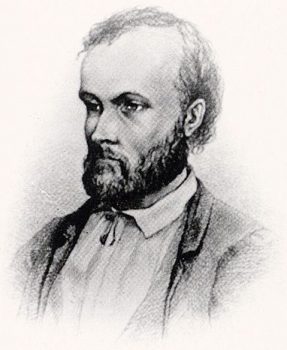
Aleksis Kivi. Drawn in 1873 almost certainly by Albert Edelfelt (1854–1905).
Aleksis Kivi’s Seitsemän veljestä (Seven Brothers, English translation 1929), is the best known and the most beloved in Finland. Its sentences have become part and parcel of the common tongue. Its events are often cited as historical happenings, its characters and their vicissitudes are now permanent national property just as the characters of Shakespeare are for the English, those of Molière for the French, or those of Cervantes for the Spaniards.
Aleksis Kivi’s life (1834–1872) is filled with paradoxes and unanswered questions. How could a village tailor’s son who has acquired only a little learning at home and who managed to graduate from secondary school, after many efforts, only at the age of 23, became an author of the first rank? How could a man who travelled within a radius of only a few dozen miles during his life know the Finnish landscape and the Finnish mind so thoroughly that his novel even today, mutatis mutandis, conveys a true picture of an entire nation? How could he free himself from the spirit and the idealised conception of the art of his own day so completely as to be able to write books sharply at variance with the other literary works of the same era, in which he followed his own path and found fully independent artistic solutions? And how could a book which is, practically speaking, the first Finnish-language novel and which thus springs up as a unique phenomenon from an inadequately cultivated linguistic soil, reach such heights as to become the supreme achievement of all Finnish literature? The enigmatic quality of Kivi’s character is further enhanced by the fact that there exists only one authentic portrait of him, drawn when he already lay dead; that the original manuscript of Seitsemän veljestä is not extant; and that of his letters, only about seventy have been preserved, some only brief notes and most of them dealing with financial arrangements. More…
The Writer’s dilemma
Issue 2/1984 | Archives online, Authors, Interviews
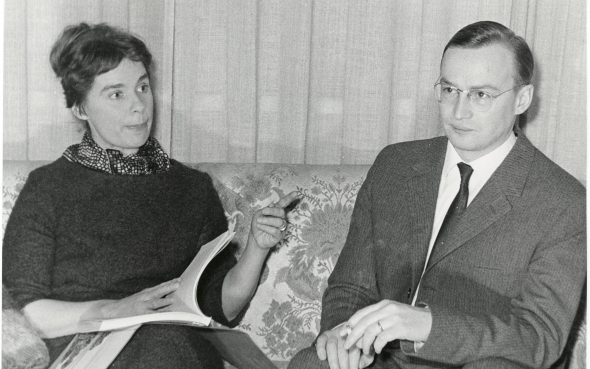
Poets Marja-Liisa Vartio and Paavo Haavikko. Photo: SKS archives
Philip Binham interviews Paavo Haavikko
I think it’s impossible to be just a writer. That would mean isolating oneself completely from the outside world – so it’s important to have other work.
The appointment is on 5 April 1984 in Paavo Haavikko’s city office. Clearly a newly-inhabited office – he recently left his post as Literary Editor for the Otava Publishing Company to become a literary consultant under the letterhead of Arthouse Ltd. A desk jumbled high with papers and photos on which my tape recorder perches precariously; Haavikko is currently working on a history of a leading Finnish industrial enterprise, Wärtsilä. Typewriters, a phone, a few odd chairs, a secretary. Haavikko himself is business-like: well-cut grey suit, well-trimmed greying hair and beard, neat dark-blue tie: When I play the recording over, our voices echo oddly in the bare, high-ceilinged rooms.
PB: May I start by asking you something about your reading?
PH: That’s a very difficult question for me because up to now I’ve had two jobs – as a writer and a publisher, so my own reading has been more or less non-existent. Writing has taken up all my leisure time. And I thought, now that I’m not in the publishing business any more I’d have time for such reading – but so far I haven’t had any, so that seems to be something for the future. More…
Chill climates
Issue 2/1984 | Archives online, Authors, Interviews
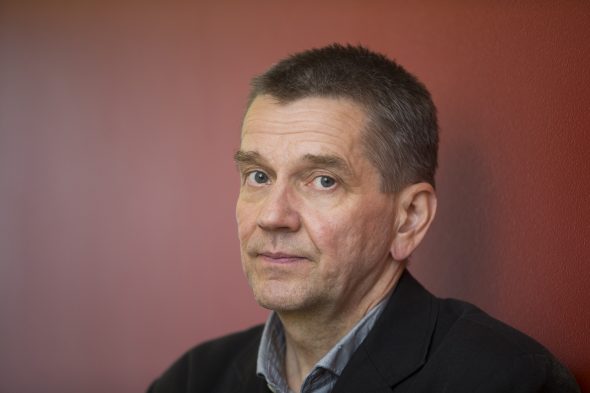
Olli Jalonen. Photo: Pekka Nieminen.
Olli Jalonen was born in 1954 and lives in Hämeenlinna. His first work, a collection of short stories entitled Unien tausta (‘The background of dreams’, 1978) and two later novels, Sulkaturkki (‘Feather coat’, 1979) and Ilo ja häpeä (‘Joy and shame’, 1981) were reviewed with exceptional warmth by the critics. His latest novel, Hotelli eläville (‘Hotel for the living’, 1983) brought him a State Prize for Literature in 1984. The awarding committee commented that the novel is ‘a representative of that rare genre in Finnish literature, the grotesque novel’. Jalonen also received the ‘Spurs of Criticism’, the annual prize awarded by the Finnish Critics’ Association. The hotel for the living is the book’s ironic name for a nuclear shelter that is being quarried into the living rock of Finland; Jalonen sets up a situation that allows him to examine the crevices of his characters’ personalities. He studies their attitudes to life with cool satire – they live in the bleak climate of buying and selling, the struggle for power and material goods, the domination of others, and submission to their fates. Interview by Markku Huotari
‘Poetry in a world under threat’ was the headline for a survey of Finnish poetry by poet and critic Väinö Kirstina that appeared in the Tampere daily newspaper Aamulehti in 1981.
Two years later that headline is just as bitingly relevant. Only one alteration is necessary: to poetry must be added prose, for prose, too, is addressing itself to that future, difficult enough to imagine, in which the threat of nuclear war may involve Finland, living in the shadow of the super powers, in a conflict in which she wishes no part.
One of the scenes in Olli Jalonen’s novel Hotelli eläville (‘Hotel for the living’) is set in a nuclear shelter that is being built inside the living rock on which Helsinki stands. Even now the planners of that ‘shelter’ use the fear of other people to their own ends, and divide them into those who will be saved and those who will perish.
A sermon on the day of judgement? Cliche? Milking of a fashionable subject? More…
Ethics and the individual
Issue 1/1984 | Archives online, Authors, Interviews
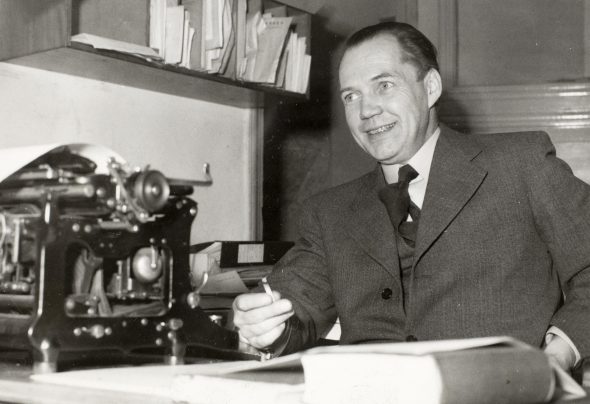
Walentin Chorell. Photo: SLS
Over one hundred stage and radio plays, twenty six novels, poetry – the extent of Walentin Chorell’s work, from the early 1940s to his death last November was huge. The Finland-Swedish writer was by profession a teacher of psychology; his writing sprang from a real need to analyze the psychological drama of human life, to study other people – and at the same time himself – through the medium of literature.
His last television play, Hyena, is to be shown in Finland this summer, and his last radio play, Utopia, is to be broadcast in the spring. Many of his radio plays have been translated into the other Nordic languages, and his works have been performed and published in more than twenty countries.
The 71-year old writer was interviewed by Glyn Jones in Helsinki two months before his death.
‘I would say that writing for radio is what gives me most satisfaction, for there no limits are placed on your imagination. There are no limits in either time or space. On the radio you can have one scene portraying your main character as a child, and in the next as an adult; you can quickly follow that main character from childhood to adulthood, and your listeners will believe in it. As for space, you can set one scene in Paris – and indicate this by making a hotel porter call out the number of a room in French – and the following one can be set in Stockholm or Helsinki, and you can do it so convincingly that your listeners will believe in it.’ More…
A life of one’s own
Issue 1/1984 | Archives online, Authors
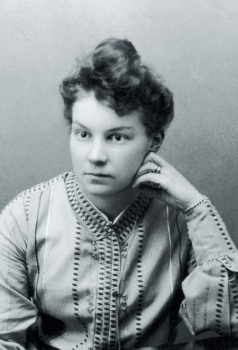
L. Onerva. Photo: Otava, 1907
When L. Onerva (1882–1972) published her novel Mirdja in 1908 she was twenty-six years old. Two previously published collections of poetry had already established a reputation for her as a promising young writer and she was also achieving a name as a first-rate critic. Her career thus began in circumstances which augured well for distinction and fame, both of which came to her, although her fame derives not only from her literary abilities – it is due in part to the notoriety of her private life. Her works, always thought to have a biographical element, are often read for glimpses of bohemian and artistic life at the start of the century.
In the puritanical climate of the period Onerva was unquestionably unusual, although Finland was not without independent and literary women. Onerva had many talents; she was well educated, and when she met Eino Leino, the most famous poet of the day, she had published her first collection of poems. This meeting changed the nature of Onerva’s life. She left her husband. Leino’s marriage also broke down and the couple ran away to Germany and Italy for a year. They were never married and both later married other people. Nevertheless, their profound friendship lasted until Leino’s death in 1926. More…
Fairy tales of a journalist
Issue 1/1984 | Archives online, Authors
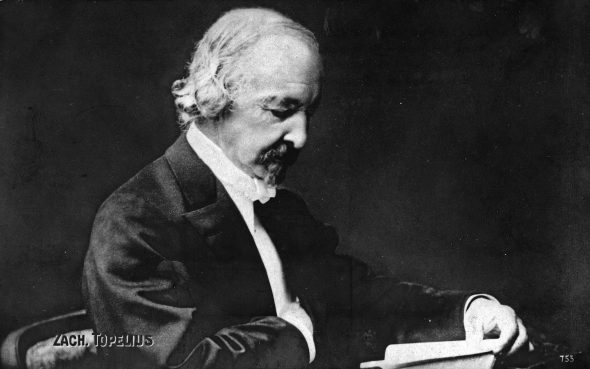
Zacharias Topelius. Photo: SLS
In 1918, Selma Lagerlöf, the Swedish novelist and recipient of the Nobel Prize for literature, was commissioned by the Swedish Academy to write a book on the life and works of Zacharias Topelius, in celebration of the centennial of his birth. As she says in the introduction to her Zachris Topelius of 1920 (where she uses the familiar contraction of the great man’s given name), she realized that she was up against the monster work-in-progress of Valfrid Vasenius, which had already reached three volumes and which would not be finished, with six, until 1930.
Lagerlöf jotted down her almost novelistic account of Topelius’s first thirty-eight years, from his birth in Ostrobothnia, as the son of a country doctor with strong folkloristic interests, to the appearance of his major patriotic poem of 1856, Islossningen i Uleå älv (‘The breakup of the ice in Uleå river’), filled with hopeful thoughts about an independent Finland. It can be reckoned that more people have enjoyed Lagerlöf’s chatty pages than have struggled with Vasenius’ positivistic monument, and that a common notion of Topelius, influenced either by Aunt Selma or schoolteachers who have partaken of her burbling spirit, is that of a man too good and emotionally too limited to be great. More…
A modern mystery play
Issue 4/1983 | Archives online, Authors
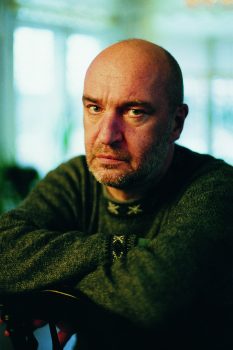
Jussi Kylätasku. Photo: Pertti Nisonen.
Jussi Kylätasku (born 1943) is a prolific writer of poetry, plays – stage and radio – film scripts and novels. Iconoclastically he casts aside the realism that is so characteristic of Finnish drama and so beloved by Finns; but at the same time Kylätasku is very Finnish: paradox is, indeed, characteristic of this infuriating writer, who has delighted critics and public alike. Perhaps the best-known of his plays is Runar ja Kyllikki (‘Runar and Kyllikki’), which was first performed in 1974; his newest work is a novel, published in November by Werner Söderström. One of his most revolutionary plays, however, is Maaria Blomma (‘Mary Bloom’), which might be called an extraordinary modern version of a mediaeval mystery play. What follows is a personal view of the director of the first performance of the play, in 1980, Väinö Vainio.
There are drama scripts, technically assured texts addressing themselves to the burning issues of the day, that inspire one at first reading to predict fruitful interpretations and lasting recognition. Unfortunately, in the Finnish theatre world such forecasts seldom come true. Almost without exception, even those plays whose first performances are successful fall into the jaws of Moloch and rapidly pass into obscurity on dim and dusty archive shelves. More…
-
Currently browsing
Interviews with Finnish authors and introductions to their work
-
RSS feed
Subscribe to RSS feed for Authors
-
List of authors and contributors
- Abu-Hanna, Umayya
- Ågren, Gösta
- Aho, Hannu
- Aho, Juhani
- Aho, Claire & Westö, Kjell
- Ahola, Suvi
- Ahti, Risto
- Ahtola-Moorhouse, Leena
- Ahvenjärvi, Juhani
- Ala-Harja, Riikka
- Alftan, Maija
- Alhoniemi, Pirkko
- Anderson, John
- Andersson, Claes
- Andersson, Jan-Erik
- Andtbacka, Ralf
- Anhava, Tuomas
- Antas, Maria
- Apunen, Matti
- Aro, Tuuve
- Aronpuro, Kari
- Autio, Milla
- Bargum, Johan
- Bargum, Marianne
- Barrett, David
- Binham, Philip
- Björling, Gunnar
- Blau DuPlessis, Rachel
- Bolgár, Mirja
- Boucht, Birgitta
- Bremer, Caj
- Bremer, Stefan
- Brotherus, Elina & Ala-Harja, Riikka
- Byggmästar, Eva-Stina
- Canth, Minna
- Carlson, Kristina
- Carpelan, Bo
- Chan, Stephen
- Chorell, Walentin
- Diktonius, Elmer
- Ekman, Michel
- Ekroos, Anna-Leena
- Enckell, Agneta
- Enckell, Martin
- Enqvist, Kari
- Envall, Markku
- Eskola, Kanerva
- Fagerholm, Monika
- Flint, Austin
- Forsblom, Harry
- Forsblom, Sabine
- Forsström, Tua
- Gothóni, Maris
- Granö, Veli
- Gripenberg, Catharina
- Gröndahl, Satu
- Grünthal, Satu
- Haanpää, Pentti
- Haapala, Vesa
- Haasjoki, Pauliina
- Haatanen, Kalle
- Haavikko, Paavo
- Hämäläinen, Helvi
- Hämäläinen, Timo
- Hännikäinen, Timo
- Hänninen, Anne
- Hannula, Risto
- Harju, Timo
- Härkönen, Leena
- Harmaja, Saima
- Hassinen, Pirjo
- Havukainen, Aino & Toivonen, Sami
- Hawkins, Hildi
- Heikkilä-Halttunen, Päivi
- Heikkonen, Olli
- Heinimäki, Jaakko
- Hejkalová, Markéta
- Hellaakoski, Aaro
- Hertzberg, Fredrik
- Hiidenheimo, Silja
- Hiltunen, Eija Irene
- Hökkä, Tuula
- Holappa, Pentti
- Hollo, Anselm
- Holmström, Johanna
- Honkala, Juha
- Hotakainen, Kari
- Huldén, Lars
- Huotari, Markku
- Huotarinen, Vilja-Tuulia
- Huovi, Hannele
- Huovinen, Veikko
- Hurme, Juha
- Hyry, Antti
- Idström, Annika
- Ingström, Pia
- Inkala, Jouni
- Isomäki, Risto
- Istanmäki, Sisko
- Itkonen, Jukka
- Jalonen, Olli
- Jama, Olavi
- Jansson, Tove
- Järnefelt, Arvid
- Järvelä, Jari
- Järvinen, Outi
- Jeremiah, Emily
- Joenpelto, Eeva
- Joenpolvi, Martti
- Joensuu, Matti Yrjänä
- Jokela, Markus
- Jokinen, Heikki
- Jokisalo, Ulla & Kortelainen, Anna
- Jones, W. Glyn
- Jotuni, Maria
- Juntunen, Tuomas
- Juvonen, Helvi
- Kähkönen, Sirpa
- Kaila, Tiina
- Kaipainen, Anu
- Kanto, Anneli
- Kantokorpi, Mervi
- Kantokorpi, Otso
- Kantola, Janna
- Karlström, Sanna
- Karonen, Vesa
- Katajavuori, Riina
- Katz, Daniel
- Kihlman, Christer
- Kiiskinen, Jyrki
- Kilpi, Eeva
- Kilpi, Volter
- Kinnunen, Aarne
- Kirstinä, Leena
- Kirstinä, Väinö
- Kirves, Jenni
- Kivi, Aleksis
- Knapas, Rainer
- Kokko, Karri
- Kokko, Hanna & Bargum, Katja
- Kontio, Tomi
- Korhonen, Riku
- Korsström, Tuva
- Koskela, Lasse
- Koskelainen, Jukka
- Koskimies, Satu
- Koskinen, Sinikka
- Krohn, Leena
- Kulmala, Teppo
- Kunnas, Kirsi
- Kupiainen, Teemu & Bremer, Stefan
- Kurkijärvi, Gene
- Kuusisto, Stephen
- Kylätasku, Jussi
- Kyrö, Tuomas
- Kytöhonka, Arto
- Laaksonen, Heli
- Lahtela, Markku
- Lahti, Leena
- Laine, Jarkko
- Laitinen, Kai
- Lander, Leena
- Lassila, Pertti
- Laurén, Anna-Lena
- Leche, Johan & Grysselius, Johan
- Lehtola, Erkka
- Lehtola, Jyrki
- Lehtonen, Joel
- Lehtonen, Soila
- Leka, Kaisa
- Lesser, Rika
- Liehu, Rakel
- Liksom, Rosa
- Lilius, Carl-Gustav
- Lindberg, Petter
- Lindblad, Kjell
- Lindgren, Minna
- Lindgren, Minna & Löytty, Olli
- Lindén, Zinaida
- Linna, Väinö
- Lintunen, Maritta
- Liukkonen, Leena
- Liukkonen, Tero
- Lomas, Herbert
- London, Mindele
- Lounela, Pekka
- Löytty, Olli
- Lundberg, Ulla-Lena
- Luntiala, Hannu
- Lydecken, Arvid
- Määttänen, Markus
- Mäkelä, Hannu
- Mäkinen, Raine
- Malkamäki, Sari
- Manner, Eeva-Liisa
- Mannerkorpi, Juha
- Manninen, Teemu
- Marttila, Hannu
- Marttila, Mervi
- Mauriala, Vesa
- Mazzarella, Merete
- McDuff, David
- Mehto, Katri
- Melleri, Arto
- Meri, Veijo
- Meriluoto, Aila
- Metsähonkala, Mikko
- Mickwitz, Peter
- Mikkola, Marja-Leena
- Mikkonen, Sari
- Mörö, Mari
- Musturi, Tommi
- Neovius Deschner, Margareta
- Nevala, Maria-Liisa
- Nevanlinna, Arne
- Nevanlinna, Tuomas
- Niemi, Irmeli
- Niemi, Juhani
- Nieminen, Kai
- Nieminen, Pertti
- Nissilä, Anna-Leena
- Nordell, Harri
- Nordgren, Ralf
- Nummi, Jyrki
- Nummi, Lassi
- Nummi, Markus
- Oja, Vesa
- Oksanen, Aulikki
- Oksanen, Kimmo
- Olsson, Hagar
- Onerva, L
- Onkeli, Kreetta
- Orlov, Janina
- Otonkoski, Lauri
- Paasilinna, Arto
- Paasilinna, Erno
- Pääskynen, Markku
- Paasonen, Markku
- Paasonen, Ranya
- Päätalo, Kalle
- Paavolainen, Nina
- Pakkala, Teuvo
- Paksuniemi, Petteri
- Palmgren, Reidar
- Papinniemi, Jarmo
- Parland, Henry
- Parras, Tytti
- Parvela, Timo
- Pekkanen, Toivo
- Peltonen, Juhani
- Pennanen, Eila
- Petäjä, Jukka
- Petterson, Viktor
- Pettersson, Joel
- Peura, Annukka
- Peura, Maria
- Pimenoff, Veronica
- Pirilä, Marja
- Pohjola-Skarp, Riitta
- Polkunen, Mirjam
- Pulkkinen, Matti
- Pyysalo, Joni
- Raevaara, Tiina
- Raittila, Hannu
- Rajala, Panu
- Rane, Irja
- Rapo, Jukka & Rotko, Lauri, Jukka
- Rasa, Risto
- Rekola, Mirkka
- Riikonen, H.K.
- Rimminen, Mikko & Salokorpi, Kyösti
- Ringbom, Henrika
- Ringell, Susanne
- Rintala, Paavo
- Roine, Raul
- Roinila, Tarja
- Rönkä, Matti
- Rönnholm, Bror
- Rossi, Matti
- Runeberg, Fredrika
- Runeberg, Johan Ludvig
- Ruohonen, Laura
- Ruuth, Alpo
- Saarikangas, Kirsi
- Saarikoski, Pentti
- Saarikoski, Saska
- Saaritsa, Pentti
- Sahlberg, Asko
- Saint-Germain, Claire
- Saisio, Pirkko
- Salama, Hannu
- Sallamaa, Kari
- Salmela, Aki
- Salmela, Alexandra
- Salmenniemi, Harry
- Salminen, Arto
- Salminiitty, Satu
- Salo, Merja
- Sammallahti, Pentti & Thrane, Finn
- Sandelin, Peter
- Sandman Lilius, Irmelin
- Säntti, Maria
- Sariola, Esa
- Sarkia, Kaarlo
- Saurama, Matti
- Savolainen, Mikko
- Saxell, Jani
- Schatz, Roman & Jarla, Pertti
- Schildt, Runar
- Schoolfield, George C.
- Seppälä, Arto
- Seppälä, Juha
- Siekkinen, Raija
- Sihvo, Hannes
- Sihvonen, Lauri
- Sillanpää, Frans Emil
- Sillanpää, Johanna
- Simonsuuri, Kirsti
- Sinervo, Helena
- Sinisalo, Johanna
- Sirola, Jouko
- Sironen, Esa
- Skiftesvik, Joni
- Snellman, Anja
- Snickars, Ann-Christine
- Södergran, Edith
- Söderling, Trygve
- Statovci, Pajtim
- Stenberg, Eira
- Strandén, Tiia
- Sund, Lars
- Suosalmi, Kerttu-Kaarina
- Susi, Heimo
- Susiluoto, Saila
- Svedberg, Ingmar
- Tähtinen, Tero
- Tahvanainen, Sanna
- Takala, Riikka
- Tamminen, Petri
- Tapio, Juha K.
- Tapola, Katri
- Tapola, Katri & Talvitie, Virpi
- Tarkka, Pekka
- Taskinen, Satu
- Tate, Joan
- Tavi, Henriikka
- Tervo, Jari
- The Editors
- Thölix, Birger
- Tietäväinen, Ville
- Tiihonen, Ilpo
- Tikka, Eeva
- Tikkanen, Henrik
- Tikkanen, Märta
- Tirkkonen, Sinikka
- Toivio, Miia
- Topelius, Zachris
- Tossavainen, Jouni
- Tuomi, Panu
- Tuominen, Maila-Katriina
- Tuominen, Mirjam
- Turkka, Jouko
- Turkka, Sirkka
- Turtiainen, Arvo
- Turunen, Heikki
- Tuuri, Antti
- Tynni, Aale
- Tyyri, Jouko
- Urbom, Ruth
- Uschanov, Tommi
- Utrio, Kaari
- Vainio, Väinö
- Vainonen, Jyrki
- Väisänen, Hannu
- Vakkuri, Juha
- Vala, Katri
- Valkeapää, Nils-Aslak
- Valkonen, Kaija
- Valoaalto, Kaarina
- Valtaoja, Esko
- Vartio, Marja-Liisa
- Venho, Johanna
- Verronen, Maarit
- Viikari, Auli
- Viita, Lauri
- Virkkunen, Juha
- Virolainen, Merja
- Virtanen, Arto
- Vuoristo, Sari
- Wahlström, Erik
- Waltari, Mika
- Warburton, Thomas
- Westerberg, Caj
- Westö, Kjell
- Westö, Mårten
- Widén, Gustaf
- Willamo, Heikki
- Willner, Sven
- Witesman, Owen
- Zilliacus, Clas
- von Koskull, Agneta
- von Schoultz, Solveig
-
Yearly archive
© Writers and translators. Anyone wishing to make use of material published on this website should apply to the Editors.
